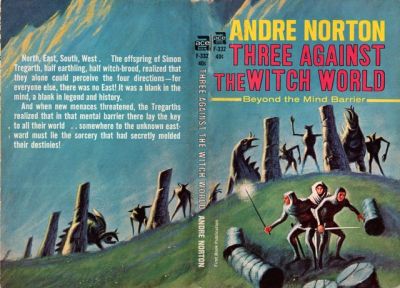“Together — one and great — apart far less!”
Three Against the Witch World (Estcarp, volume 3)
By Andre Norton

26 Jun, 2015
0 comments
1965’s Three Against the Witch World returns to Andre Norton’s Witch World, a generation after the events of Witch World and Web of the Witch World. This sequel sees Simon Tregarth and his witchy wife Lady Jaelithe relegated to off-stage status. The novel focuses on their triplets: Kyllan the fighty one, Kemoc the smart one, and Kaththea the witchy one.
All three children were born to do great things, as predicted by a fell portent, but only Kaththea is of interest to the Women of Power of Estcarp. Only Kaththea is female and therefore a potential witch. When Kaththea reaches a certain age, the witches bear her off to be educated according to their ways. Dread supernatural protections prevent her brothers from rescuing her. Kaththea is lost.
For the moment.
The Lady Loyse has refused to take up her claim to Karsten, a claim based on a forced marriage she had fled. This has left a power vacuum in Karsten. Ambitious Pagar of Geen filled that vacuum, unifying Karsten under his rule. As so many have discovered before him, Pagar learned that ruling is harder than conquering. Lest internal dissension force him from his throne, he sought an enemy against whom all Karsten would unify.
He found that enemy in the witches of Estcarp.
Although the witches prove to have a rather impressive defense against an invasion like Pagar’s, the magical working leaves the witches drained and weak, unable to maintain the wards that have imprisoned Kaththea. This allows Kyllan and Kemoc to rescue their sister from forcible indoctrination.
Escape does not mean safety. Even weakened as they are, the witches’ reach is long. There seems to be no place in the known world where the trio can flee to safety. Not in the known world.…
None in Estcarp have ever explored the vast, unknown lands to the east; an ancient spell hides them from all those native to the known lands. The natives cannot even think of the eastern lands, or wonder why they are forbidden. But the sibling trio, thanks to their father’s blood, are immune to the spell. Flight east will place them beyond any witchy retaliation.
But, as they will find out, the cost will be entanglement in a vast, forgotten war of good and evil.
~oOo~
While what the witches do to Pagar seems a bit inconsistent with the earlier books (as in “why didn’t they uncork that kind of magic on the Kalder? Even the Kalder are probably going to notice having mountains walk across them.”) I suspect the witches have a saying along the lines of “Let the expendable guy from Earth have a run at the alien horrors first!”
I have to say, the diplomatic arts of the Eastern Continent are rudimentary. The witches play a long game aimed at grabbing Kaththea for their own, While I will give them points for waiting until Simon and Jaelithe were unavailable to protect Kaththea, I cannot help but think that if the witches hadn’t been so ostentatiously nasty towards Simon for having magical talent, they might have been able to persuade Simon and Jaelithe that an education was in Kaththea’s best interest. The witches have been consistently high-handed. And it’s not like anyone else in the known world is using diplomatic techniques more subtle than “stab them a bit and see if that convinces them.”
The plot development that ensures Simon and Jaelithe get the role of Sir (Almost) Not Appearing in This Play really felt like the set up to another book. I wonder if it was.
I suspect that there are people who encountered this book at just the right age who absolutely love it. Encountering it as a fifty-four-year-old, I kept seeing shadows of the novel that could have been.
The problem is that in the era when Norton was publishing, long fantasy novels were still a novelty for American publishers; The Lord of the Rings had just been published in an authorized American edition, and the age of legions of LotR imitators was still in the future. Publishers wanted short books that could become inexpensive paperbacks. Norton had to cram an awful lot of plot into less than two hundred pages. I found many aspects of the land to the east interesting but undeveloped. To get from where she began to where she wanted to end, Norton had to use certain narrative short-cuts (Fate Wills It So! In particular is a very important tool in her Witch World toolkit). She was also denied the room to explore the individual characters of her three protagonists, even though their differing talents would have had interesting effects on character.
I am not entirely certain why Norton chose Kyllan as her viewpoint character. Seen from one angle, the closure of his narrative arc seems rushed and second-hand. Looked at from another, the events at the end of the novel are blatant hooks for future novels in an ongoing series. Well, if there are more books about the three kids I have not read them. I have no idea if I should read the end as “but our adventures were only beginning!”.
I was a bit frustrated with the novel, but I am sure that there those who still love it, or would love it. Three Against the Witch World is available as part of the 2004 omnibus Lost Lands of the Witch World.
